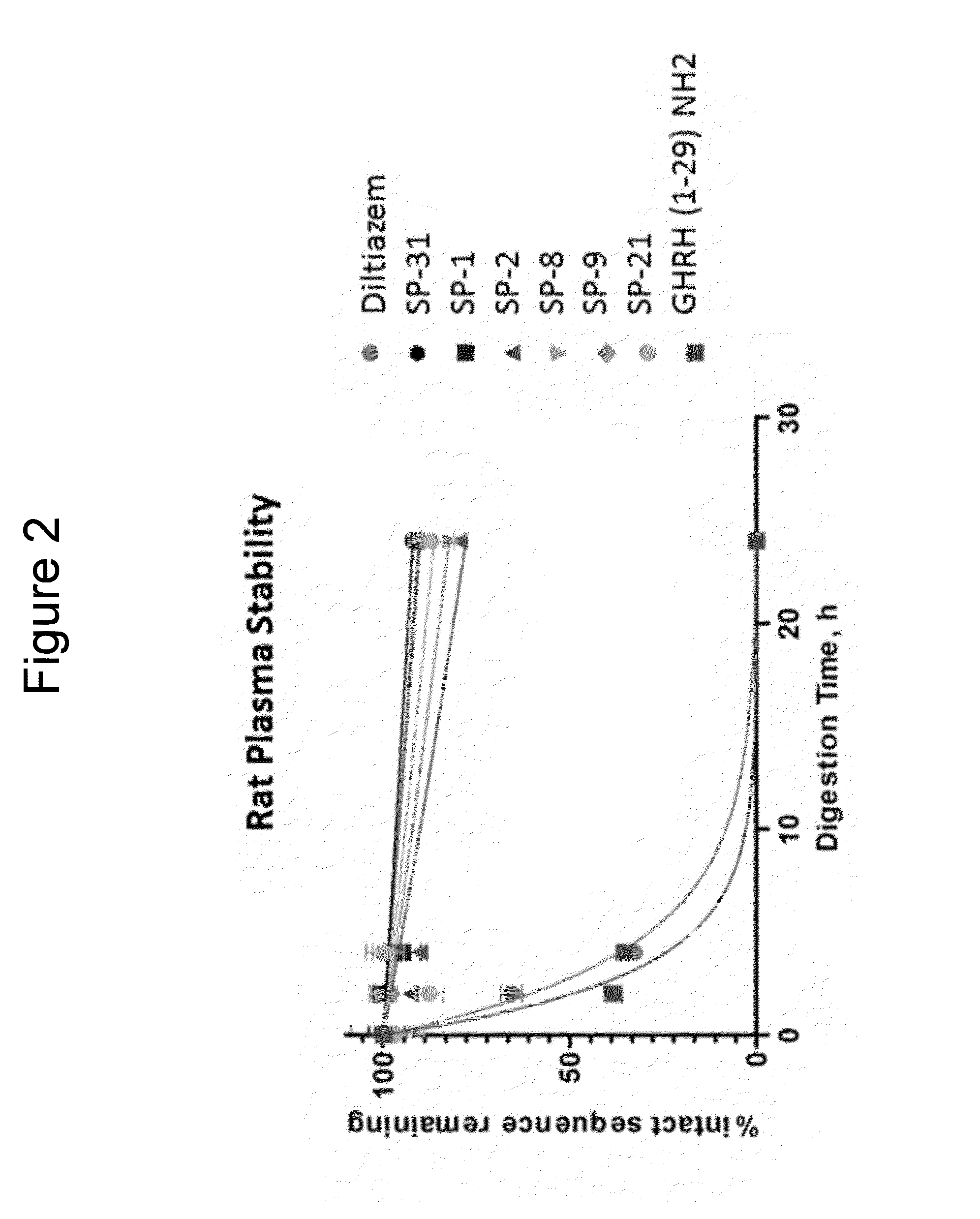Peptidomimetic macrocycles
- Summary
- Abstract
- Description
- Claims
- Application Information
AI Technical Summary
Benefits of technology
Problems solved by technology
Method used
Image
Examples
example 1
Peptidomimetic Macrocycles of the Invention
[0373]Peptidomimetic macrocycles were synthesized, purified and analyzed as previously described and as described below (Schafmeister et al., J. Am. Chem. Soc. 122:5891-5892 (2000); Schafmeister & Verdine, J. Am. Chem. Soc. 122:5891 (2005); Walensky et al., Science 305:1466-1470 (2004); and U.S. Pat. No. 7,192,713). Peptidomimetic macrocycles were designed by replacing two or more naturally occurring amino acids with the corresponding synthetic amino acids. Substitutions were made at i and i+4, and i and i+7 positions. Peptide synthesis was performed either manually or on an automated peptide synthesizer (Applied Biosystems, model 433A), using solid phase conditions, rink amide AM resin (Novabiochem), and Fmoc main-chain protecting group chemistry. For the coupling of natural Fmoc-protected amino acids (Novabiochem), 10 equivalents of amino acid and a 1:1:2 molar ratio of coupling reagents HBTU / HOBt (Novabiochem) / DIEA were employed. Non-nat...
example 2
Metabolism by Purified Protease
[0379]Linear peptides and cross-linked peptidomimetic macrocycles were tested for stability to proteolysis by Trypsin (MP Biomedicals, Solon OH) by solubilizing each peptide at 10 μM concentration in 200 μL 100 mM NH4OAc (pH 7.5). The reaction was initiated by adding 3.5 μl of Trypsin (12.5 μg protease per 500 μL reaction) and shaking continually in sealed vials while incubating in a Room Temperature (22±2 C). The enzyme / substrate ratio was 1:102 (w / w). After incubation times of 0, 5, 30, 60 and 135 min the reaction was stopped by addition of equal volume of 0.2% trifluoroacetic acid. Then, the solution was immediately analyzed by LC-MS in positive detection mode. The reaction half-life for each peptide was calculated in GraphPad Prism by a non-linear fit of uncalibrated MS response versus enzyme incubation time. Results are shown in FIGS. 1A and 1B.
example 3
GHRHR Agonism Measured by cAMP
[0380]GHRH (1-29) and cross-linked peptidomimetic macrocycles were tested for agonism at the human GHRH receptor (hGHRHR) at various concentrations. Human 293 cells transiently or stably expressing hGHRHR were detached from cell culture flasks with versene (Lifetechnologies), suspended in serum-free medium (50k cells / assay point), and stimulated for 30 min at RT with GHRH (1-29) (Bachem) or cross-linked peptidomimetic macrocycles. cAMP was quantified using an HTRF®-based assay (CisBio) and used according to the manufacturers instructions. An EC50% for each agonist was calculated from a non-linear fit of response vs dose (GraphPad Prism). The maximum response was determined by stimulating with 10 μM GHRH (1-29). Results are shown in FIG. 3.
PUM
| Property | Measurement | Unit |
|---|---|---|
| Fraction | aaaaa | aaaaa |
| Fraction | aaaaa | aaaaa |
| Fraction | aaaaa | aaaaa |
Abstract
Description
Claims
Application Information
 Login to View More
Login to View More - R&D
- Intellectual Property
- Life Sciences
- Materials
- Tech Scout
- Unparalleled Data Quality
- Higher Quality Content
- 60% Fewer Hallucinations
Browse by: Latest US Patents, China's latest patents, Technical Efficacy Thesaurus, Application Domain, Technology Topic, Popular Technical Reports.
© 2025 PatSnap. All rights reserved.Legal|Privacy policy|Modern Slavery Act Transparency Statement|Sitemap|About US| Contact US: help@patsnap.com



